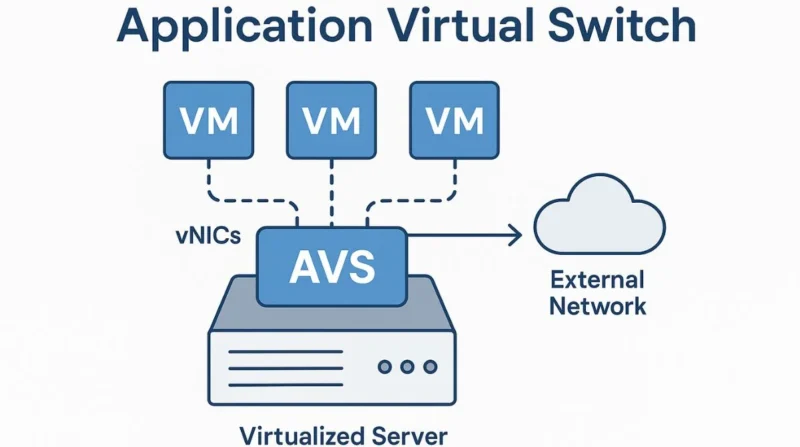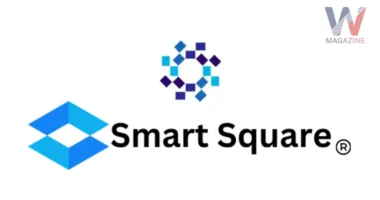Table of Contents
- A Beginner’s Guide to Application Virtual Switches
- Types of Application Virtual Switches
- Key Features
- Virtual Switches: A Key Component You Shouldn’t Ignore
- Security Features of Application Virtual Switches
- How Does an Application Virtual Switch Work?
- Performance Optimization with Application Virtual Switches
- Integration with Cloud Platforms
- Application Virtual Switch vs. Traditional Switch
- Benefits of Application Virtual Switches
- Real-World Examples of AVS
- Common Use Cases for Application Virtual Switches
- Popular AVS Platforms
- Understanding AVS Networking Components
- Challenges and Considerations
- Best Practices for Using Application Virtual Switches
- FAQs
- Conclusion
Imagine a world where your apps and devices communicate flawlessly. That’s the power of an application virtual switch. In 2025, with cloud computing, virtual machines, and IoT devices everywhere, virtual switches keep data flowing smoothly. They’re vital for businesses, developers, and even home networks.
A Beginner’s Guide to Application Virtual Switches
An application virtual switch is software that manages network traffic between virtual machines (VMs), containers, or apps in a virtual environment. It’s like a traffic cop for data, directing packets without physical hardware. Virtual switches are key to cloud and virtualization setups.
Defining “Virtual Switch”
A virtual switch works like a physical network switch but runs in software. It connects virtual devices, like VMs or containers, within a server or across a network. Instead of cables, it uses code to route data, making it flexible and cost-effective.
“Application” Matters
An application virtual switch focuses on app-specific needs. It ensures apps perform well, stay secure, and scale easily in cloud or microservices setups. For example, it prioritizes bandwidth for a streaming app while securing a payment app.
Types of Application Virtual Switches
Virtual switches vary by platform and use case. Here are the main types.
1. Standard Virtual Switch
Found in hypervisors like VMware vSphere, these connect VMs to each other and external networks. They’re simple and great for small setups.
2. Distributed Virtual Switch
Used in large environments, like data centers, these span multiple servers for centralized management. They’re ideal for enterprises with many VMs.
3. Open vSwitch
An open-source option, Open vSwitch is flexible and supports cloud platforms like OpenStack. It’s popular for custom setups.
Key Features
- Software-defined No physical hardware needed
- Operates within a virtual machine or container environment
- Optimized for application-layer communication
- Supports network segmentation, security policies, and load balancing
- Highly customizable and programmable
Virtual Switches: A Key Component You Shouldn’t Ignore
Whether you’re building a private cloud, running a business, or hosting apps on Azure or AWS, AVS plays a critical role. Here’s why:
1. Efficiency
No more tangled cables or bulky hardware. AVS makes networking lean and efficient.
2. Scalability
As your apps grow, your virtual network can scale alongside, automatically.
3. Security
You can isolate workloads and enforce policies without changing physical infrastructure.
4. Cost-Effectiveness
Say goodbye to expensive hardware upgrades. Everything is software-based.
Security Features of Application Virtual Switches
Security is a top priority in networking, and application virtual switches play a critical role in keeping data safe. By isolating traffic, enforcing policies, and integrating with security tools, they protect virtual environments from threats. Whether you’re running a small app or a massive cloud platform, these features ensure your network stays secure. Let’s explore how virtual switches safeguard your data.
- Traffic Segmentation: Virtual switches create isolated network segments, like virtual LANs (VLANs), to separate sensitive data. For example, a hospital’s patient records app is isolated from its public website, preventing unauthorized access.
- Access Control Policies: Switches enforce rules on which apps or VMs can communicate. This stops malicious apps from accessing critical systems, like a hacked IoT device reaching a payment server.
- Encryption Support: Many switches integrate with protocols to encrypt data in transit. This ensures a banking app’s transactions remain private, even in a public cloud.
- Intrusion Detection Integration: Virtual switches work with tools like firewalls or intrusion detection systems (IDS). They flag suspicious traffic, such as unusual data spikes from a compromised VM.
- Micro-Segmentation: This advanced feature isolates individual apps or workloads. For instance, in a microservices setup, each service (e.g., login, cart) gets its own secure zone, limiting attack spread.
- Centralized Monitoring: Switches provide real-time logs and analytics. IT teams can spot threats, like repeated failed login attempts, and act quickly.
Real-world example: A retail company uses VMware NSX’s virtual switch to secure its cloud-based inventory app. The switch isolates inventory data from customer-facing apps, encrypts data, and monitors for threats. When a hacker tried accessing the system, the switch’s policies blocked the attempt, saving the company from a breach.
How Does an Application Virtual Switch Work?
An AVS functions similarly to a traditional switch but entirely in software.
1. Step-by-Step Workflow
- Virtual Machines are created on a host system using a hypervisor like VMware, Hyper-V, or KVM.
- Each VM is connected to the AVS using virtual network interface cards (vNICs).
- The AVS inspects data packets, determines their destination, and routes them to the correct VM or external network.
- All of this happens within the memory and processing of the host machine.
2. Tools and Platforms That Use AVS
- VMware vSwitch
- Microsoft Hyper-V Virtual Switch
- Open vSwitch (OVS)
- Cisco Application Virtual Switch for ACI
- Nutanix AHV Switch
Performance Optimization with Application Virtual Switches
Performance is key in networking, and application virtual switches are built to maximize speed and efficiency. They optimize data flow, reduce latency, and ensure apps run smoothly, even under heavy traffic. From gaming apps to enterprise databases, these features boost performance. Let’s explore how virtual switches keep networks fast.
- Load Balancing: Switches distribute traffic across VMs or containers, preventing bottlenecks. For example, a streaming app stays smooth during peak hours.
- Quality of Service (QoS): Prioritizes critical apps, like giving a video call app more bandwidth than a background update.
- Traffic Shaping: Controls data flow to avoid congestion. This ensures a cloud-based game doesn’t lag during server spikes.
- Low Latency Design: Switches process packets quickly, reducing delays. This is vital for real-time apps like online trading platforms.
- Scalable Architecture: Supports growing workloads, like adding VMs for a website during a product launch, without slowdowns.
- Analytics and Tuning: Provides performance metrics, letting IT teams tweak settings, like increasing bandwidth for a busy app.
Example: A gaming company uses Open vSwitch for its multiplayer platform. The switch balances traffic across game servers, prioritizes player data, and minimizes latency. During a global tournament, it handled millions of users without crashes, earning rave reviews.
Integration with Cloud Platforms
Application virtual switches are the backbone of cloud computing, seamlessly integrating with platforms like AWS, Azure, and Google Cloud. They connect apps, manage traffic, and enhance cloud performance. Whether you’re a developer or business owner, understanding this integration is key. Here’s how virtual switches power the cloud.
- Native Support: Cloud providers embed virtual switches in their infrastructure. AWS’s VPC uses switches to route traffic between EC2 instances.
- Hybrid Cloud Compatibility: Switches connect on-premises servers to cloud apps, like linking a local database to Azure-hosted analytics.
- Container Orchestration: In Kubernetes, switches like Calico manage container traffic, ensuring microservices communicate efficiently.
- Scalability: Switches handle dynamic cloud workloads, like scaling a retail app during holiday sales, without manual setup.
- Security Integration: Pair with cloud security tools, like AWS Security Groups, to enforce policies and encrypt data.
- Monitoring Tools: Integrate with cloud dashboards, like Azure Monitor, to track performance and spot issues in real time.
Application Virtual Switch vs. Traditional Switch
Let’s compare these two side-by-side to see the difference more clearly.
| Feature | Traditional Switch | Application Virtual Switch |
| Hardware Dependency | Requires physical device | Software-based |
| Scalability | Limited | Easily scalable |
| Deployment Speed | Slower (manual) | Faster (automated) |
| Cost | High upfront costs | Lower total cost |
| Security | Physical segmentation | Policy-based segmentation |
| Use Case | Office LANs, Servers | Cloud, Virtual Machines, Containers |
Benefits of Application Virtual Switches
Now that you know what AVS is and how it compares to traditional networking, let’s explore the real advantages.
1. Performance
Modern AVSs are designed to handle high-throughput, low-latency network traffic across applications.
2. Granular Security
You can set firewall rules, VLAN tagging, and micro-segmentation per application or workload.
3. Flexibility
Integrate with APIs, automation scripts, and cloud orchestration tools like Kubernetes or Terraform.
4. Multi-Tenant Isolation
Perfect for shared environments like cloud services, where each tenant needs isolated resources.
5. Lower Costs
Use existing hardware and scale based on demand saving money and reducing overhead.
Real-World Examples of AVS
1. Enterprise IT: Virtual Desktop Infrastructure (VDI)
Large companies use AVS to connect thousands of virtual desktops securely and efficiently.
2. Cloud Providers: Microsoft Azure AVS
Microsoft offers Azure VMware Solution (AVS) to help businesses migrate VMware workloads into the cloud seamlessly.
3. Testing Environments
QA teams set up isolated test environments using AVS no need to worry about affecting the production network.
4. Healthcare & Finance
Highly regulated industries use AVS for compliance-ready data segmentation and secure application hosting.
Common Use Cases for Application Virtual Switches
Let’s look at where AVS is making a big impact.
1. Cloud Migration
AVS helps lift and shift existing apps to the cloud without changing the networking logic.
2. Hybrid Cloud Architecture
Combine on-prem and cloud resources using AVS to ensure seamless connectivity.
3. Software-Defined Networking (SDN)
AVS is a core building block of SDN, allowing dynamic and programmable networks.
4. Container Networking
Kubernetes, Docker, and other platforms use virtual switches to connect containers.
5. Edge Computing
AVS powers real-time, lightweight deployments close to the end-user.
Popular AVS Platforms
1. Open vSwitch (OVS)
- Open-source virtual switch
- Supports OpenFlow and other open standards
- Ideal for Linux environments and SDN labs
2. VMware vSwitch
- Built into VMware ESXi
- Seamless for enterprises using VMware tools
- Can be upgraded to vSphere Distributed Switch (VDS)
3. Microsoft Hyper-V Virtual Switch
- Works within Windows Server
- Easy integration with Windows-based VMs
- Supports NAT, firewall rules, and more
4. Cisco AVS for ACI
- Tailored for Cisco’s Application Centric Infrastructure (ACI)
- Offers deep visibility, automation, and policy enforcement
Understanding AVS Networking Components
When working with an application virtual switch, you’ll encounter several key components:
1. Virtual NIC (vNIC)
Each virtual machine connects to the AVS through a virtual NIC, similar to a regular network card.
2. Uplink Port
This connects the AVS to the physical network allowing data to flow in and out of the virtual environment.
3. Port Groups
Logical groupings of switch ports with shared policies (e.g., security, VLAN tagging).
4. Security Rules
Firewall policies, MAC address filtering, and isolation rules all live in the AVS software.
Challenges and Considerations
No solution is perfect. Here are some limitations and how to deal with them.
1. Resource Usage
Since AVS runs on the host, it consumes CPU and memory—so plan your infrastructure accordingly.
2. Complexity
Setting up AVS with advanced rules and automation can be complex for beginners. Use templates or tools like Terraform.
3. Compatibility
Not all virtual switches work with all hypervisors or cloud platforms. Choose your stack wisely.
Best Practices for Using Application Virtual Switches
Make your AVS setup smooth and secure with these tips:
- Monitor traffic using built-in tools or external plugins
- Use VLANs or segmentation to isolate workloads
- Keep security rules up-to-date
- Regularly patch and update AVS software
- Document network flows and policies clearly
FAQs
Q:1 Can I use an AVS on my home computer?
Yes, if you’re using virtual machines on platforms like VirtualBox or Hyper-V.
Q:2 Is AVS only for big companies?
Not at all. Startups and small businesses benefit from AVS just as much, especially for testing and development.
Q:3 Do I need special hardware?
Nope. AVS is software-defined, but make sure your host machine has sufficient resources.
Q:4 Is AVS the same as a virtual router?
No. A virtual switch connects VMs within the same network. A virtual router connects different networks.
Conclusion
The application virtual switch is more than just a buzzword it’s a foundational part of modern cloud, edge, and virtual computing. Whether you’re spinning up VMs, managing enterprise workloads, or building a next-gen cloud-native app, AVS gives you the flexibility, control, and scalability you need.









